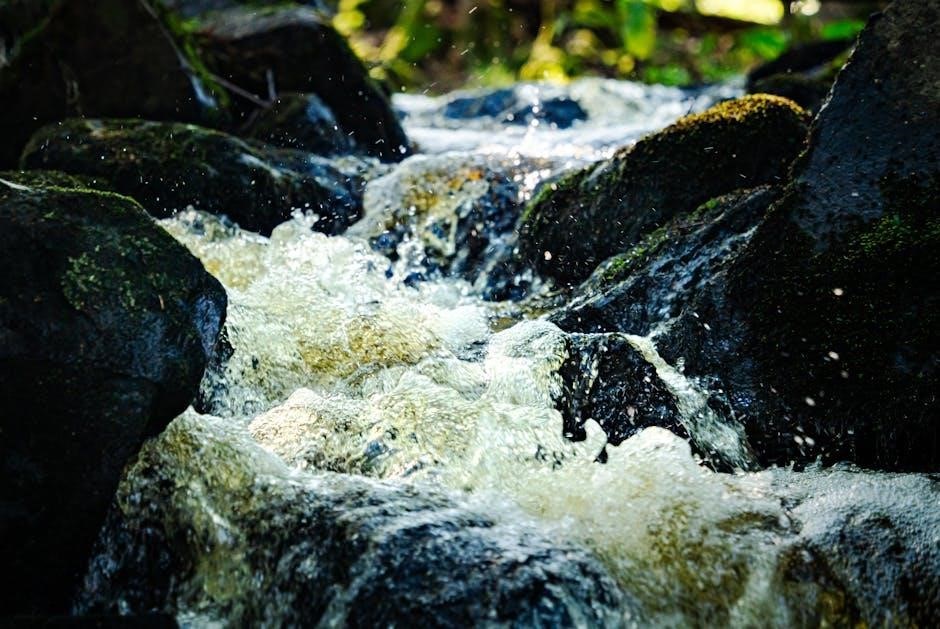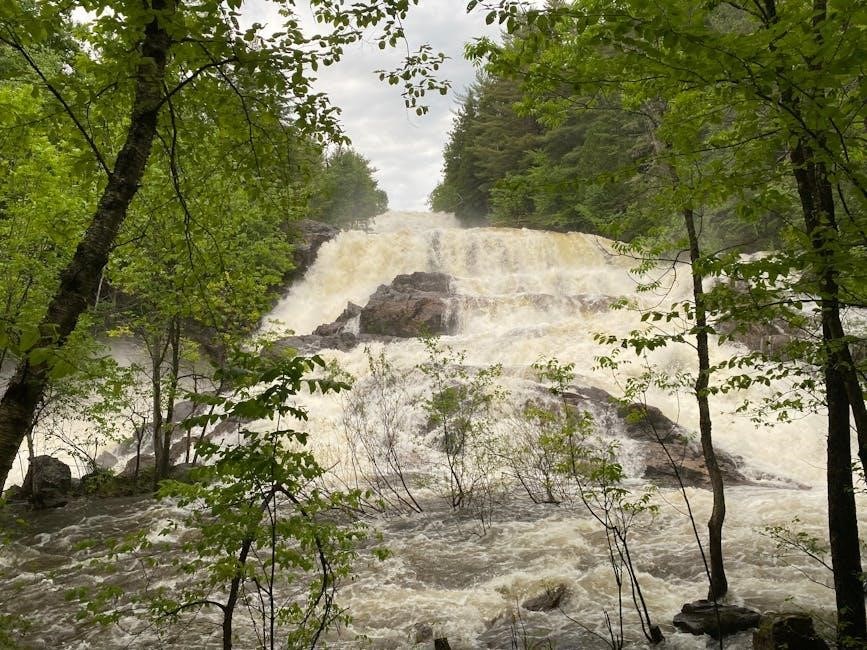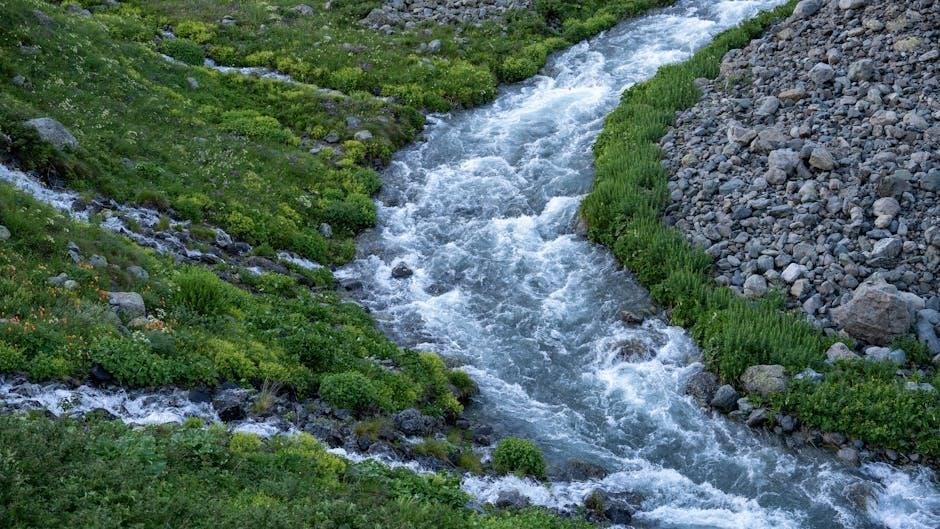Energy flow in ecosystems is the unidirectional transfer of energy from the Sun to producers, then through consumers and decomposers, sustaining life and ecosystem processes.
1.1 Definition of Energy Flow
Energy flow refers to the unidirectional movement of energy through an ecosystem, beginning with producers who capture solar energy and transfer it to consumers and decomposers. This process is essential for sustaining life and ecosystem functions, as energy is transformed and utilized at each trophic level, ultimately being dissipated as heat. Unlike nutrient cycling, energy flow is not cyclic and progressively diminishes as it moves through the system.
1.2 Importance of Energy Flow in Ecosystems
Energy flow is crucial for ecosystem functioning, sustaining food chains, and maintaining ecological balance. It determines the distribution of energy between producers and consumers, influencing ecosystem productivity. The 10% rule highlights energy transfer inefficiency, shaping trophic structures. Understanding energy flow aids in managing ecosystems, conserving biodiversity, and predicting environmental impacts, ensuring sustainable resource use and ecosystem health. It underpins life’s continuity and ecological stability.
1.3 Key Components of Ecosystems: Producers, Consumers, Decomposers
Ecosystems consist of producers (autotrophs like plants), consumers (heterotrophs like animals), and decomposers (fungi, bacteria). Producers convert solar energy into biomass via photosynthesis, forming the energy base. Consumers obtain energy by consuming other organisms, while decomposers break down organic matter, recycling nutrients. Together, these components facilitate energy flow and nutrient cycling, maintaining ecosystem balance and supporting life at all levels. Their interactions are vital for ecological stability and productivity.

Energy Sources and Producers
The Sun is the primary energy source for ecosystems, powering producers like plants and algae; These organisms convert solar energy into organic matter through photosynthesis, forming the energy base for all life.
2.1 Role of Producers in Energy Flow
Producers, such as plants and algae, are the foundation of energy flow in ecosystems. They capture solar energy through photosynthesis, converting it into chemical energy stored in organic compounds. This energy is then transferred to herbivores and higher trophic levels, sustaining the entire ecosystem. Producers’ efficiency in energy conversion directly impacts the productivity and stability of the ecosystem, making them indispensable in the energy flow process.
2.2 Photosynthesis and Energy Conversion
Photosynthesis is the primary mechanism by which producers convert solar energy into chemical energy. Chlorophyll-containing organisms use sunlight, carbon dioxide, and water to produce glucose and oxygen. This process captures a small fraction of solar energy, storing it in organic molecules that fuel the ecosystem. Efficient energy conversion through photosynthesis is crucial for supporting life and maintaining energy flow across trophic levels in an ecosystem.
2.3 Types of Producers: Autotrophs and Heterotrophs
Producers are organisms that create their own food, forming the base of ecosystems. Autotrophs, like plants and algae, produce energy through photosynthesis, converting sunlight into organic matter. Heterotrophs, such as animals and fungi, cannot produce their own food and rely on consuming other organisms for energy. This distinction highlights the fundamental roles of producers in initiating energy flow within ecosystems, supporting both autotrophic and heterotrophic life forms.

Trophic Levels and Food Chains
Trophic levels represent the feeding hierarchy in ecosystems, while food chains illustrate the linear transfer of energy from producers to consumers, supporting ecosystem productivity and structure.

3.1 Definition of Trophic Levels
Trophic levels are the feeding positions in an ecosystem, representing the hierarchy of who eats whom. Each level transfers energy to the next, starting from producers (autotrophs) like plants, which capture solar energy, to primary consumers (herbivores), secondary consumers (carnivores), and tertiary consumers (top predators). Decomposers, though not part of the trophic hierarchy, break down organic matter, releasing nutrients and energy back into the ecosystem. This structure is fundamental to understanding energy flow and ecosystem dynamics, as it illustrates how energy moves unidirectionally through the system, supporting life and maintaining ecological balance. Trophic levels are essential for analyzing food chains and webs, providing insights into the efficiency of energy transfer and the stability of ecosystems. They also highlight the interconnectedness of species and the critical role each plays in sustaining the flow of energy within their environment. By examining these levels, scientists can better comprehend the intricate relationships within ecosystems and the factors influencing their productivity and resilience. Additionally, understanding trophic levels aids in predicting how environmental changes might impact energy distribution and, consequently, the health of the ecosystem as a whole. This knowledge is vital for conservation efforts and managing ecosystems effectively to ensure their continued functionality and biodiversity.
3.2 Structure of Food Chains: From Producers to Tertiary Consumers
Food chains are linear sequences showing energy transfer from producers to consumers. Producers, like plants, form the base, capturing solar energy through photosynthesis. Herbivores (primary consumers) eat producers, followed by carnivores (secondary consumers), and apex predators (tertiary consumers). Each level transfers about 10% of the previous level’s energy, illustrating the inefficiency of energy flow. This hierarchy supports ecosystem stability and sustains biodiversity, with each organism playing a vital role in the energy flow process.
3.3 Ecological Pyramids: Energy, Biomass, and Numbers
Ecological pyramids visually represent the flow of energy, biomass, and the number of organisms at each trophic level. Energy pyramids show a progressive decrease in energy from producers to consumers, reflecting the 10% transfer rule. Biomass pyramids depict the total mass of living organisms, while pyramids of numbers illustrate population sizes. These tools help analyze ecosystem structure and energy dynamics, emphasizing the efficiency of energy flow and the hierarchy within ecosystems, from producers to apex consumers.

Energy Transfer Between Trophic Levels
Energy transfer between trophic levels is inefficient, with only 10% of energy passing to the next level, due to metabolic processes, heat loss, and ecological factors affecting efficiency.
4.1 The 10% Rule: Energy Loss Between Trophic Levels
The 10% rule states that only about 10% of energy is transferred from one trophic level to the next, while the remaining 90% is lost as heat or through metabolic processes. This inefficiency is due to energy expenditure on growth, reproduction, and survival, as well as ecological factors like food digestion and environmental conditions. The rule highlights the limitations of energy flow, shaping ecosystem structures and productivity.
4.2 Factors Affecting Energy Transfer Efficiency
Energy transfer efficiency between trophic levels is influenced by ecological efficiency, food quality, digestion, and environmental conditions. Poor digestion reduces energy absorption, while metabolic costs and non-assimilated food lower transfer rates. Environmental stressors like temperature and resource availability further impact efficiency. Additionally, energy allocation for growth, reproduction, and survival diverts energy, making the process inherently inefficient and shaping ecosystem dynamics and productivity at each trophic level.

4.3 Ecological Consequences of Energy Loss
Energy loss between trophic levels impacts ecosystem stability and productivity. Reduced energy transfer limits population sizes and food chain length, affecting species diversity. The 10% rule results in fewer top predators, influencing ecosystem dynamics. This loss also decreases biomass at higher levels, affecting ecosystem carrying capacity and resilience, ultimately shaping the structure and function of ecosystems and their ability to support life.
Decomposers and Detritus Food Chains
Decomposers break down organic matter, recycling nutrients and releasing energy. Detritus food chains parallel grazing pathways, ensuring efficient nutrient cycling and energy return to ecosystems.
5.1 Role of Decomposers in Energy Flow
Decomposers, such as bacteria and fungi, play a vital role in energy flow by breaking down dead organic matter into simpler substances. This process releases energy stored in detritus back into the ecosystem, making nutrients available for producers. Decomposers ensure nutrient recycling, enabling producers to reuse resources for photosynthesis. Their activity sustains ecosystem productivity and maintains energy balance, linking the detritus food chain with grazing pathways to complete the energy cycle.
5.2 Grazing vs. Detritus Food Chains

Grazing food chains involve the transfer of energy from producers to herbivores and carnivores, while detritus food chains focus on decomposers breaking down organic matter. Grazing pathways primarily support higher trophic levels, whereas detritus pathways recycle nutrients back to producers. Both chains coexist in ecosystems, creating a Y-shaped energy model that ensures efficient energy flow and nutrient cycling, enhancing ecosystem stability and productivity through complementary processes.
5.3 Nutrient Cycling and Energy Release
Nutrient cycling involves the return of nutrients to producers through decomposers, while energy is released as heat during metabolic processes. Decomposers break down organic matter, recycling nutrients like carbon, nitrogen, and phosphorus. This process ensures nutrients are available for new production, sustaining ecosystem productivity. Energy, however, is not recycled and is progressively lost, maintaining the unidirectional flow of energy through the ecosystem, essential for its functioning and balance.

Models of Energy Flow
Models of energy flow, such as single-channel, Y-shaped, and double-channel, depict how energy moves through ecosystems, from producers to consumers and decomposers, illustrating energy distribution patterns.
6.1 Single Channel Energy Flow Model

The single-channel energy flow model represents energy moving unidirectionally through one pathway, either the grazing or detritus food chain. This model simplifies ecosystem complexity, showing energy transfer from producers to consumers in a linear sequence. While it illustrates basic energy flow, it doesn’t account for the coexistence of both grazing and detritus pathways in natural ecosystems, making it less comprehensive than more complex models like the Y-shaped energy model.
6.2 Y-Shaped Energy Model: Grazing and Detritus Pathways
The Y-shaped energy model illustrates the coexistence of grazing and detritus food chains in an ecosystem. Energy flows from producers to consumers through two pathways: the grazing pathway, where herbivores consume live plants, and the detritus pathway, where decomposers break down dead organic matter. This model highlights the dual pathways of energy flow, showcasing the ecosystem’s efficiency in cycling energy and nutrients through both living organisms and decomposers.
6.3 Double Channel Energy Flow Model
The double channel energy flow model represents two parallel pathways: one for grazing food chains and another for detritus food chains. In this model, energy flows from producers to herbivores and decomposers simultaneously, ensuring efficient energy utilization. Decomposers process dead organic matter, returning nutrients to the ecosystem, while grazers transfer energy through consumption. This dual-channel system highlights the complex interplay between living organisms and detritus in maintaining ecosystem balance and energy cycling.
Biological Magnification and Its Implications
Biological magnification occurs when toxins accumulate in higher trophic levels, threatening ecosystem health and biodiversity through bioaccumulation of harmful substances like pesticides and heavy metals.
7.1 Definition and Causes of Biological Magnification
Biological magnification is the accumulation of toxins in higher trophic levels due to bioaccumulation, where harmful substances like pesticides increase in concentration as they move up food chains. This occurs because energy flows from producers to consumers, transferring these toxins across trophic levels. Persistent pollutants, such as DDT, are not easily broken down, leading to higher concentrations in apex predators, with severe ecological consequences, including biomagnification in top predators.
7.2 Impact on Ecosystem Health and Energy Flow
Biological magnification disrupts ecosystem health by accumulating toxins in higher trophic levels, reducing energy transfer efficiency. Persistent pollutants like DDT affect apex predators, causing physiological disorders and reproductive issues. This imbalance destabilizes food webs, diminishes biodiversity, and disrupts energy flow, ultimately weakening ecosystem resilience and productivity, highlighting the critical need for conservation efforts to mitigate such ecological threats.

7.3 Case Studies: Persistent Pollutants in Food Chains
Case studies reveal how persistent pollutants like DDT and mercury biomagnify in food chains, harming apex predators and humans. For example, mercury accumulates in fish, affecting neurological development in consumers. Similarly, DDT disrupts bird reproduction, showcasing how energy flow carries toxins upward, endangering ecosystem health and highlighting the need for pollution control to protect biodiversity and human well-being.
Energy flow in ecosystems is crucial for sustaining life, transferring energy unidirectionally from producers to consumers, with significant losses at each trophic level, emphasizing conservation’s role in ecosystem sustainability.
8.1 Summary of Key Concepts
Energy flow in ecosystems is unidirectional, starting from the Sun to producers, then consumers, and finally decomposers. The 10% rule highlights energy loss at each trophic level, while ecological pyramids and food chains illustrate energy distribution. Decomposers recycle nutrients, sustaining ecosystem productivity. Understanding these processes aids in managing ecosystems and recognizing the importance of conservation in maintaining energy balance and biodiversity. These concepts underscore the delicate interplay of energy flow and ecosystem health.
8.2 Practical Applications of Energy Flow Knowledge
Understanding energy flow aids in managing ecosystems, optimizing agriculture, and promoting conservation. It helps predict population dynamics, design sustainable practices, and mitigate pollution impacts. By identifying energy bottlenecks, strategies can enhance resource efficiency and reduce waste. This knowledge also informs environmental policies, fostering biodiversity and ecosystem resilience, ensuring balanced energy distribution for future generations while addressing climate change and resource depletion challenges effectively.
